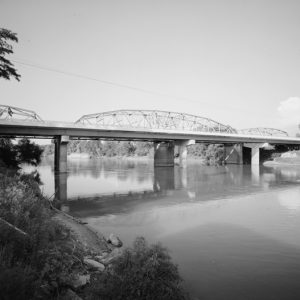calsfoundation@cals.org
Black River Bridge (Historic)
The Black River Bridge is the name given to a historic bridge spanning the Black River in Randolph County. Built as part of U.S. Highway 67, the Black River Bridge was added to the National Register of Historic Places on April 9, 1990, and maintained by the Arkansas Department of Transportation.
The Pocahontas (Randolph County) section of Highway 67 opened in February 1931. The confluence of Highways 90 and 115 with U.S. Highway 67 in Pocahontas required a bridge to provide for safe travel across the Black River. To begin the construction of a bridge, the State Highway Commission needed federal approval through the U.S. Congress and through the War Department. This approval was set in place to ensure that river traffic on the Black River was not impeded by the new bridge or its construction process; river traffic at this time was economically vital to the area and necessary for military river vessels.
The Arkansas State Highway Commission preempted the opening of the Pocahontas section of Highway 67 by submitting a bill for approval. Through the efforts of U.S. Representative Pearl P. Oldfield, Congress passed a bill of approval for the construction of the Black River Bridge on April 12, 1930. Federal approval stipulated that construction had to begin one year after congressional and departmental approval. The State Highway Commission was not able to do so and was required to re-apply for congressional approval. Re-approval was made through Representative John E. Miller and was passed by Congress on April 22, 1932.
After congressional approval, the State Highway Commission applied to the War Department and attended a public hearing on October 4, 1932, in Memphis, Tennessee. The War Department extended final approval on October 28, which allowed the State Highway Commission to begin construction on a more permanent bridge across the Black River. The State Highway Commission subsequently opened the bidding process. The Pittsburgh-Des Moines Steel Company won the contract and erected a swing bridge in 1934.
The swing-type bridge allowed river traffic to continue operating on the Black River. When swung open, the bridge created two channels about 100 feet wide. This bridge is one of three of this type in the state, the others being the St. Francis River Bridge near Madison (St. Francis County) and the Judsonia Bridge in Judsonia (White County).
The AHTD widened the section of U.S. Highway 67 over the Black River by two lanes in 1986 and constructed a two-lane bridge adjacent to the historic Black River Bridge. This new bridge obstructed the old swing bridge’s ability to open for river traffic. The historic Black River Bridge remained as a static two-lane bridge over the Black River, but it was slated for destruction in 2016 to allow for a replacement that can handle a greater volume of commercial traffic. Demolition occurred on October 2, 2016.
For additional information:
Adams, W. Clarence. “Historic Pocahontas.” Arkansas Gazette, September 25, 1938, p. 2.
“Black River Bridge.” National Register of Historic Places nomination form. On file at Arkansas Historic Preservation Program, Little Rock Arkansas. Online at https://www.arkansasheritage.com/arkansas-historic-preservation-program (accessed December 23, 2025).
Dalton, Lawrence. History of Randolph County. Little Rock: Democrat Printing and Lithographing Company, 1946.
Dougan, Michael B. “The Doctrine of Creative Destruction: Ferry and Bridge Law in Arkansas.” Arkansas Historical Quarterly 39 (Summer 1980): 136–158.
Morris, Stan. “Black River Bridge in Its Final Months.” Jonesboro Sun, March 8, 2016, pp. 8A–9A.
“State Highway 67 Formally Opened by Commissioner.” Pocahontas Star Herald, February 12, 1931, p. 1.
Zachary Elledge
Jonesboro, Arkansas








Comments
No comments on this entry yet.